382e. Karoline Paulus to Charlotte Schiller in Weimar: Würzburg, 11 March 1804 [*]
[Würzburg] 11 March [1804]
Father and I have been quite healthy and well this winter, considerably better than in Jena, [1] and this benefit outweighs by far all the negative things one can justifiably say about Würzburg. The people here have little culture or education, little natural understanding, and are lethargic in a way I would not have expected in a place where Stein wine is cultivated. [2]
We are quite happy to be living in the same building as the Hovens. [3] She is almost the only social contact I have, for I have for some time now returned entirely to my old, quiet lifestyle because I am simply not interested in going out to social gatherings, where nothing sensible is ever said.
We have been fairly well freed of the “malady,” [4] as Schiller put it to Hufeland. This malicious creature tried to keep Madam Hoven from having anything to do with me by spreading lies that were as malicious as they were stupid; once she saw she was not being successful, she became quite impertinent toward Madam Hoven, and now we no longer see her at all. Schelling, too, has demonstrated on this occasion that he is an obedient husband and that the evil influence of this Madame Lucifer is exerting a powerful effect on him indeed. It is fortunate that our apartment is separated from hers by a church, where according to Catholic custom they diligently burn incense. [5]
I rarely see Madam Hufeland. There are so many casinos, masked balls, concerts, etc. here that boredom rarely prompts her to call on me. [6]
Count von Thürheim is presently here, an extremely charming man who is working with all his power for the betterment of the university.
Tell Goethe on occasion that Madam Lucifer is doing him the honor of letting people know, in a modest way, that he is to be reckoned among the number of her quiet admirers. He will no doubt be not a little proud of this distinction.
Karoline Paulus
Notes
[*] Source: Charlotte von Schiller und ihre Freunde, 3:187–88. Back.
[1] The Paulus couple addressed each other using the diminutive Swabian forms “dear mother” and “dear father,” lieb Mütterle, lieb Väterle, though also the normal forms Mutter, Vater, and Mütterchen (Reichlin-Meldegg 1:344n20, 2:194). Back.
[2] Würzburg Stein wine has been produced for centuries in an extremely large vineyard with limestone soil situated along the Main River north and northwest of the center of town in a location whose shape and sunlight exposure have historically produced excellent harvests. A friend of the Paulus family, namely, Goethe, is known to have valued this wine. The wine was traditionally bottled in what are known as Bockbeuteln (excerpt from an early postcard):
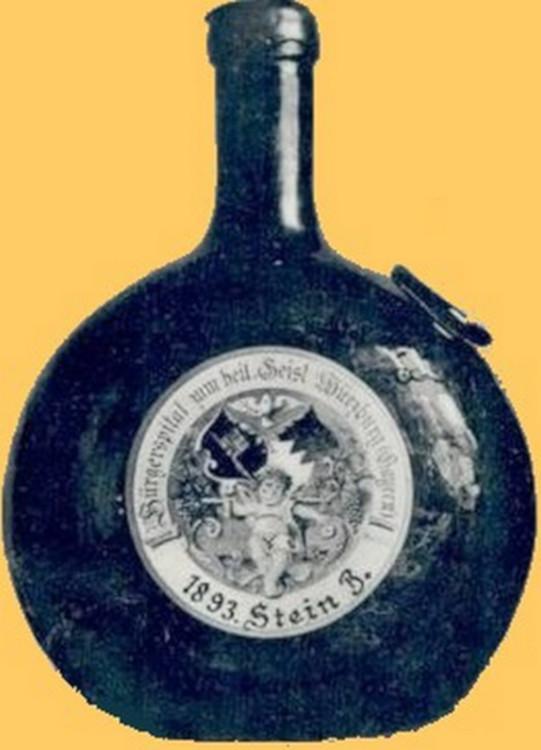
The Steinberg, the expansive area where the vineyards are still located, is shown at the top of the following illustration.The triangular complex of the Old University, where Caroline and Schelling along with the Pauluses and von Hovens lived, is at bottom right, the Marienburg Castle (mentioned below) at bottom center across the Main River (Würzburg mit Umgebung Maassstab 1200 Schritte. Auf genommen u. / gezeichnet von Oberlieut. F. Harrach. Grav [Würzburg 1840]):

See a later (1874) account of the wine in the anonymous article “The German Vintage [XI and XII],” The Pall Mall Budget: Being a Weekly Collection of Articles Printed in the Pall Mall Gazette from Day to Day, with a Summary of News 13 (1875) Friday, December 18, 1874, pp. 14–15, here p. 15:
Stein and Leisten Wine
Würzburg, Nov. 24A popular wine grown in any part of the world is certain to be largely imitated and to be the subject of endless substitutions; and the famous Stein Wine, vintaged on the heights which dominate Wurzburg, one of the most antiquated and picturesque of German cities, is no exception to the well-established rule.
Every one knows the squat pot-bellied flasks termed “bocks-beuteln,” in which wine professing to be genuine Stein is sold, and which is to be bought in London for less than half the price it commands on the Main. The chalky ridge known as the Stein forms a very extensive vineyard, it is true; still it has merely three proprietors, the King of Bavaria and the Julius and Holy Ghost Hospitals.
The lowest price which the firstnamed is now charging for Stein wine is 60 florins the dozen bottles, equal to upwards of 8s. 6d. per bottle, and his co-proprietors in the vineyard most certainly do not largely undersell his Bavarian Majesty. The fact is, nearly the whole of the so-called Stein wine disposed of in England, with the larger portion of that sold in Germany, is nothing more than some common Palatinate growth, to be bought on the spot for about half-a-crown per gallon. For Leisten wine the price ranges from slightly beyond 10s. to 12s. per bottle. The Leisten growth is in fact much the superior one, although by no means so popular as its rival, which has been renowned for centuries, as vouched by the ancient distich :—
At Hochheim on the Main, Wurzburg on the Stone, And Bacharach on the Rhine, the three best wines are grown.Wurzburg lies in a hollow, shut in on all sides by hills planted with nothing but vines, of which there are several thousand acres. The Leist vineyard slopes downward towards the Main from the foot of the picturesque Marienberg fort, which, perched on the summit of a commanding height, dominates the city and forms so conspicuous an object in all views of it. The extensive buildings of the fort not only shield the vines from the winds, but reflect the sun’s rays upon them, thereby materially conducing to the perfect ripening of the grapes at a much earlier period than is customary.
The Stein vineyard is situated on the opposite side of the Main, and when viewed from the picturesque bridge, studded with incongruous colossal statues — such as Joseph and the Virgin Mary and Charlemagne and Pepin — seems to rise up as an immense rampart behind the city. Here the river acts as a reflector, throwing back the sun’s rays on the lower portions of the slope, where the finest wine is naturally vintaged. An altogether inferior growth is produced on the hill to the north, known as the Middle Stein, and also in the Harfe vineyard, situated in the rear of the latter.
Here a view of Würzburg directly from the Stein vineyards ([1] from Ludwig Lange and Ernst Rauch, Original-Ansichten der historisch merkwürdigsten Staedte in Deutschland [Darmstadt 1837], n.p.; [2] excerpt from Daniel Nikolaus Chodowiecki, Winkopps Leben des Prior Hartungus [1782]; Herzog Anton Ulrich-Museum; Museums./Signatur DChodowiecki AB 3.472):
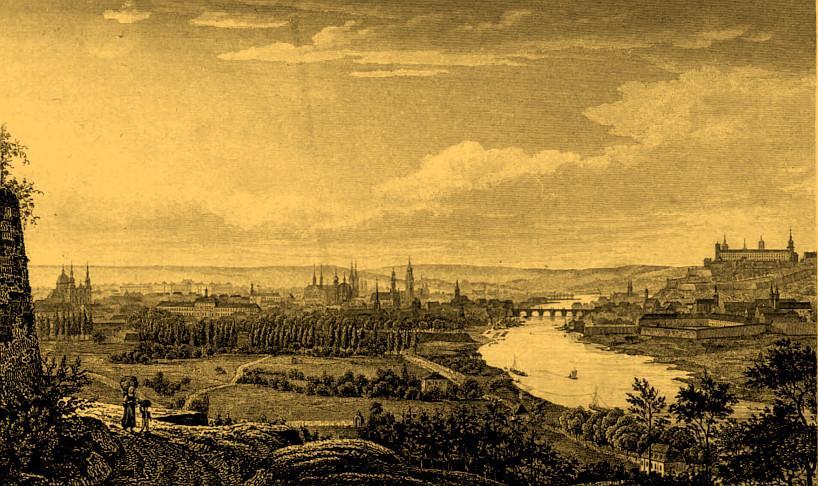
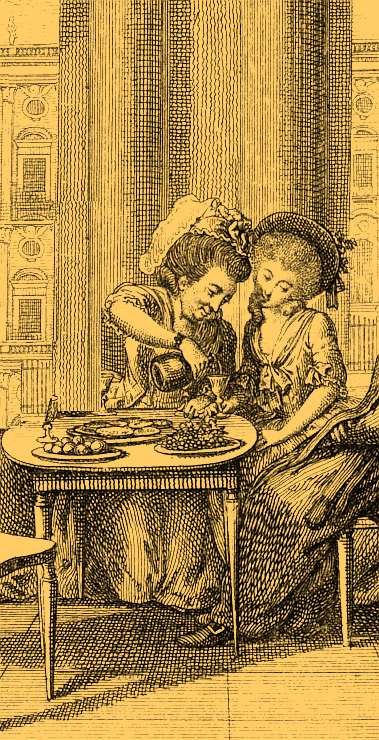
[3] See the supplementary appendix on the Schellings’ residence in Würzburg (Universität Würzburg, Universitätsarchiv):

[4] I.e., Caroline. Back.
[5] E. G. Cuthbert F. Atchley, A History of the Use of Incense in Divine Worship (New York 1909), illustration following p. 126:
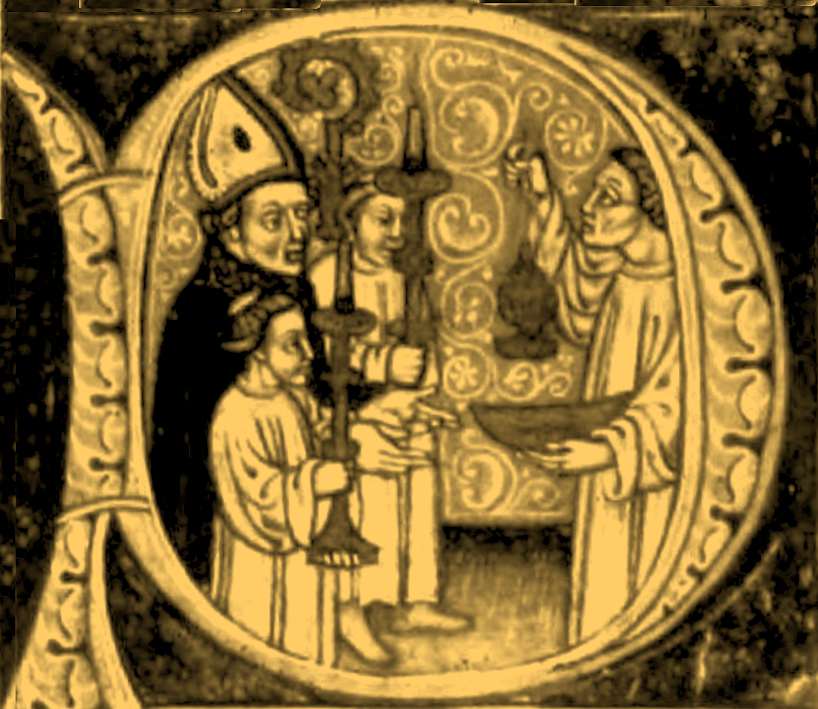
It is uncertain exactly when the Paulus and von Hoven families moved from their apartments in the Old University opposite Schelling and Caroline and into the Borgias Building, which was not yet finished when the three families arrived. Either way, the apartment of Karoline Paulus would have been separated from that of Caroline by the Neubaukirche (Neuester Plan der Kreishauptstadt Würzburg, mit nächster Umgebung und Angabe der Stadt Strassenbau-Projecte [n.d.]):

If Karoline Paulus’s apartment was still in the Old University, the arrangement would have been as follows (17th- or 18th-century engraving; Würzburg Universität, Universitätsarchiv):
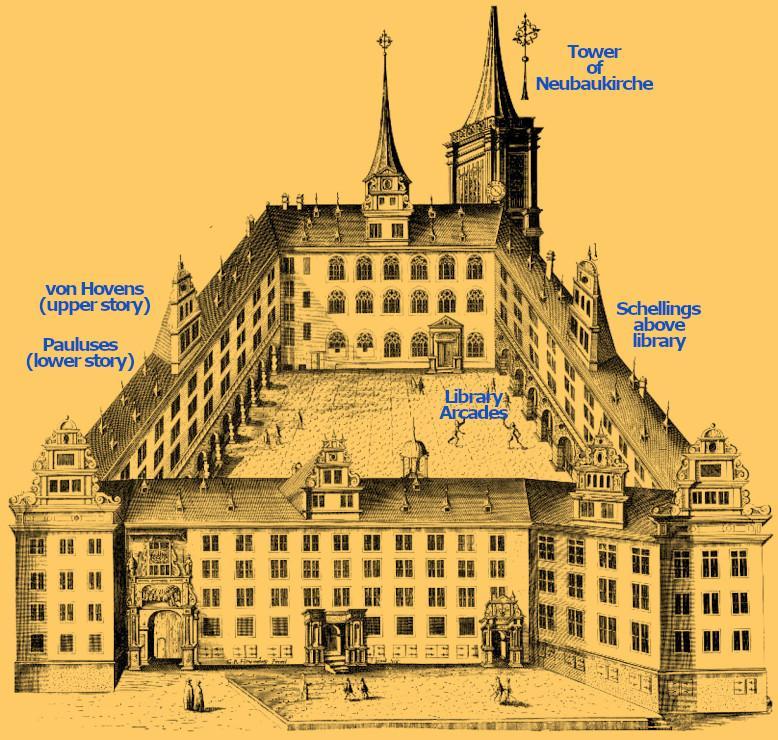
Here a photo of the Neubaukirche before its destruction in World War II (S. Göbl, Würzburg: Ein kulturhistorisches Städtebild, 4th ed. [Würzburg 1901], 117):
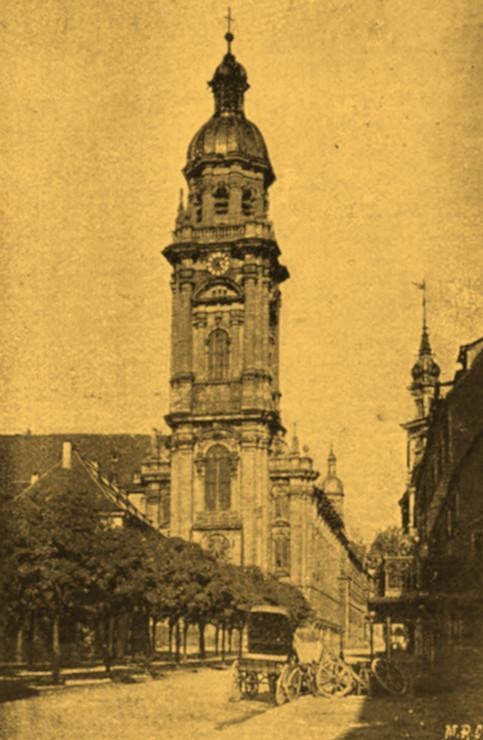
[6] See Carl Gottfried Scharold, Würzburg und die umliegende Gegend, für Fremde und Einheimische kurz beschrieben (Würzburg 1805), 15–16, 54:
Balls. During the winter, especially around the time of carnival, extremely popular entré- and masked balls are held, along with dining, in the grand, handsome, and pleasantly illuminated halls of the theater building with Herr Bevern, at the locale of royal glazier Limb next to the Church of St. Mary, and in the former redoute in the Reurer Gasse with Peter Himmelstein.
The house rules guests must observe are posted publicly in the various halls.
A police commissar and an officer share supervisory duties in maintaining peace and order.
Hackney coaches stand ready on the street at the entrances to the ball houses to drive guests to and away from the locales. . . .
Concerts. Aficionados of music enjoy a multitude of opportunities for attending concerts during the winter, when nature measures out her own pleasures more sparingly to people, forcing them instead to pay more homage to the arts and sciences.
In addition to the excellent local royal ensemble, which for several years now has given concerts in the hall of royal glazier Limb, occasionally non-resident or itinerant musicians similarly come to town to entertain the public with their art. Back.
Translation © 2017 Doug Stott
